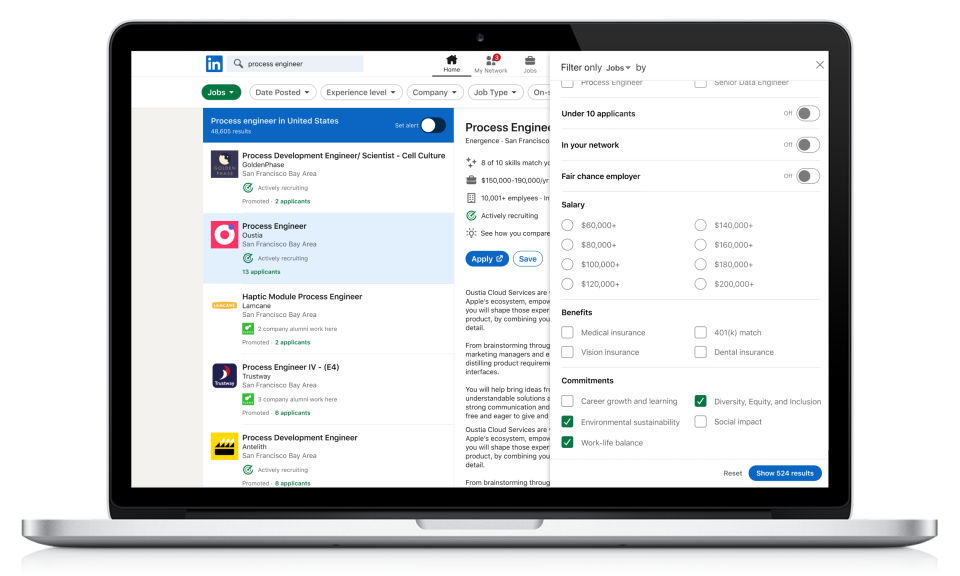Amazon tops LinkedIn's list of best places to work, jobseeker priorities shift to workplace culture
There have been more than 171,000 people in the tech industry laid off so far this year, according to data tracked by layoffs.fyi, but those looking for work are not in a "beggars can't be choosers" mindset. According to new data from LinkedIn, people are gravitating to workplaces that align with their values, and their values include a range of factors like diversity and skills growth, not just how much money they'll make.
The company today published its annual list of best places to work, where Amazon held on to the top spot, and Google owner Alphabet dropped from number two last year to number five this year. The interesting thing about the rankings, now in their eighth year, is that they provide a snapshot of how individuals' priorities are changing.
Specifically, the rankings are based not just on practical assessments of -- for example -- what percentage of people were laid off, but also how companies scored on softer and cultural skills, which it said speak to how long a person is more likely to stay at a company.
So, along with factors like "company stability" (companies had to have less than 10% workforce layoffs in the past year to qualify), other details like growth and learning opportunities, equity in the workplace and strong company culture, it said, are "of growing importance for job seekers as they prioritize organizations that align with their own values." (The full list of eight factors: ability to advance, skills growth, company stability, external opportunity, company affinity, gender diversity, educational background and employee presence in the country.)
LinkedIn's conclusion: This more rounded view of workplaces has become more of the norm when it comes to where people gravitate to work, and that's been the case even in a tight labor market where hundreds of thousands of people are getting laid off due to worsening economic conditions.
In keeping with that conclusion, LinkedIn used the data to kick off a new tool it's offering jobseekers when constructing their job searches.
They now will have a filter to look for workplaces that have policies and priorities in areas like diversity and inclusion (DEI), career growth and learning, work-life balance, social impact and environmental sustainability. Via LinkedIn Learning, the company is also offering some free courses to help users learn how to seek out those job opportunities more effectively.

Image Credits: LinkedIn
LinkedIn itself and its owner Microsoft intentionally get left out of the rankings, but in addition to Amazon and Alphabet, just one other technology company made the top-10 list, Apple at number eight. Twitter, unsurprisingly, is not in the rankings at all, but nor are other biggies like Facebook owner Meta, Netflix and Samsung.
Tech-adjacent AT&T was number six, while tech management consultancy Thoughtworks was at number nine. Others in the top 10 included banks (ironic given what's been happening in the banking sector in the past few months), and two companies in the healthcare space, UnitedHealth Group and Kaiser Permanente. We're publishing the basic full list below, and you can see the more detailed rankings and descriptions here.
The bigger message here is that LinkedIn continues to tweak its platform to remain relevant in the employment game, whatever rules that game may take.
LinkedIn, with 900 million registered users, has been a major hub for people looking for work in the so-called knowledge economy for decades at this point. In the last few years, it has made a number of efforts to be responsive to the socioeconomic wave that's washed over us.
The COVID-19 pandemic saw LinkedIn add in tools to help employers indicate which jobs could be carried out remotely without a need for relocation to offices that were unlikely to be open anyway.
Then, the start of the layoffs tsunami saw a lot of people adopt LinkedIn's "open to work" badge to flag quickly and visually to those browsing their profiles that they were happy to entertain job offers -- a big shift away from the more discreet cues LinkedIn has built over the year to help users flag themselves to recruiters.
The big question is whether or not factors like cultural values are a sign of our times, or if these parameters will remain permanent priorities among jobseekers, changing the bigger picture for how recruiters can capture the best talent -- and indeed what "talent" will look like -- in the future.
Best places to work 2023:
Amazon
Wells Fargo
JP Morgan Chase & Co.
Bank of America
Alphabet
AT&T
UnitedHealth Group
Apple
Thoughtworks
Kaiser Permanente
Boeing
Verizon
Comcast
Citi
Accenture
IBM
Lockheed Martin
GE
The Walt Disney Company
Northrop Grumman
UPS
FedEx
Dell Technologies
Edwards Lifescience
PwC
Mastercard
State Farm
Lowe's Companies
Fidelity Investments
Intel
Oracle
Deutsche Telekom
Eli Lilly and Company
EY
Raytheon Technologies
Capital One
U.S. Bank
Ford Motor Company
PepsiCo
Tetra Pak
Bristol Myers Squibb
Morgan Stanley
Medtronic
Delta Air Lines
CFGI
Siemens
Vitesco Technologies
Synchrony
Atlassian
Tata Consultancy Services

 Yahoo News
Yahoo News 
